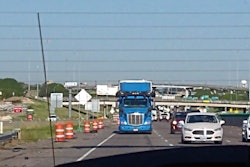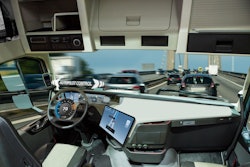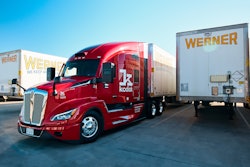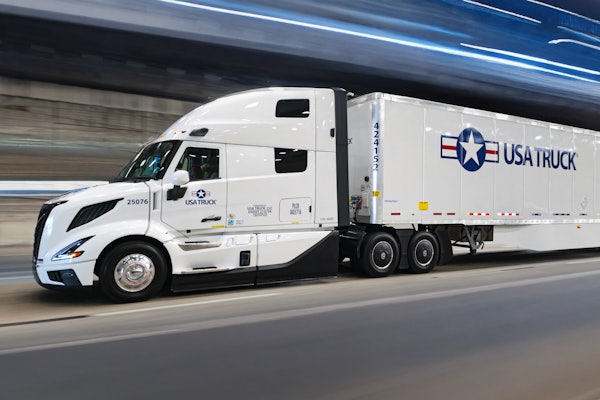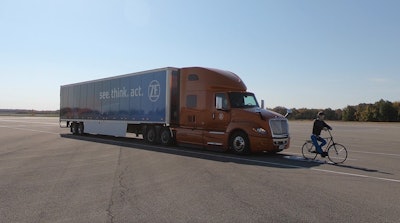
We’re inside a tractor-trailer barreling toward a mock Prius with California plates in East Liberty, Ohio at 50 mph when ZF’s latest OnGuardMAX Autonomous Emergency Braking System kicks in and quickly brings the rig to a standstill a few yards ahead of the faux car.
 ZF also made its Electric Power Steering available to reporters in the Peterbilt shown on the right during its Technology Day this week in East Liberty, Ohio. The Peterbilt on the left had conventional hydraulic steering which made steering through the cones noisier and required more effort.Commercial Carrier Journal
ZF also made its Electric Power Steering available to reporters in the Peterbilt shown on the right during its Technology Day this week in East Liberty, Ohio. The Peterbilt on the left had conventional hydraulic steering which made steering through the cones noisier and required more effort.Commercial Carrier Journal
Prior to automatically engaging the brakes, ZF’s OnGuardACTIVE gave Brodie an audible beeping alert, a visual alert on the driver’s side screen and a haptic alert by way of a light pulse on the brakes. Since Brodie did not hit the brakes the system didn’t waste time in automatically applying the brakes, causing all three of the truck’s occupants, including this reporter, to lurch forward as the rig came to safe, smooth stop.
“The camera and radar both saw the object and both decided to react to it with enough confidence to come in with that high level of deceleration,” Brodie explained from the driver’s seat on the Transportation Research Center test track.
Wabco Maxxus 2.0 disc brakes on the International LT, along with drum brakes on the unloaded trailer, quickly took commands from the third generation OnGuardMAX system, which – compared to the prior iteration – has increased automated braking in front of a stationary vehicle from 20mph to 50mph.
The next brake test will have the truck beelining toward a mannequin on a bike. The truck will be approaching what Brodie and the rest of the ZF R&D team calls the VRU, or vulnerable road user, at 20mph.
[Related: High tech may not be enough to overcome truck safety issues]
“When we do the approach on that vulnerable road user – that mannequin on the bicycle – the previous system wouldn't have responded to that at all,” Brodie explains.
 Reporters also had a chance to experience ZF's 8-speed PowerLine transmission in a Peterbilt box truck equipped with a 6.7-liter PACCAR PX-7 engine. Shifting was smooth and effortless on a challenging Transportation Research Center test course in East Liberty, Ohio which included down and uphill runs on a 22% grade. The engine brake eased the truck into a safe, comfortable ride downhill. The truck went uphill without breaking a sweat. The PowerLine transmission is already available.Commercial Carrier Journal
Reporters also had a chance to experience ZF's 8-speed PowerLine transmission in a Peterbilt box truck equipped with a 6.7-liter PACCAR PX-7 engine. Shifting was smooth and effortless on a challenging Transportation Research Center test course in East Liberty, Ohio which included down and uphill runs on a 22% grade. The engine brake eased the truck into a safe, comfortable ride downhill. The truck went uphill without breaking a sweat. The PowerLine transmission is already available.Commercial Carrier Journal
“This portion of the system is designed for urban environments, where you're driving through the city and there's pedestrian traffic around and maybe the driver's distracted trying to figure out where he is going,” Brodie says. “The system can respond to these other VRUs the older systems would not respond to.”
While such automation, especially automated emergency braking, makes good sense, it’s not always an easy sell as Sudhive Nair, ZF’s product line leader of vehicle dynamics, explains a few minutes after the test.
“The harder portion is the older drivers who are not used to the technology and who are still in the process of embracing it,” Nair says.
Standing close by, Dirk Wohltmann, ZF’s director of engineering for the Americas, explains that driver concerns often hinge on their own performance. A fleet executive that had a chance to experience the latest OnGuardMAX a day earlier told Wohltmann about the man versus machine dilemma.
“[Monday], one of the fleet gentlemen was saying that drivers have been making mistakes and there's been nobody to correct them,” Wohltmann recalled. “Now, when these systems come in, you are being corrected. You now realize the mistakes you’re making because before you kept on making the same mistakes again and again thinking that it’s normal.”
But it’s not normal, at least when it comes to optimizing safety, and if you let your guard down, OnGuard MAX will be very quick to remind you.
Getting better though testing
Improving OnGuardMAX is no easy task. Increasing automated braking from 20 to 50mph in their latest model takes plenty of runs on the test track and a lot of analysis.“The test guys don't just come out and do these runs over and over,” Brodie explains. “What happens is for each version of software that comes out, there's a list of tests that need to be done and when they run those tests, if they find something that isn't quite as it should be, then we get another version of software.”
Moving vehicles get in on the act too.
“There are tests that are done with moving vehicles, which is part of the system that we were demonstrating years ago – back in 2013,” Brodie says. “So we're showing the exciting new features here where we have this higher deceleration and the vulnerable road user and the stationary car with the high deceleration.”
A long list of specific tests have to be performed, which leads to improvements and eventually a product launch. During Tuesday’s run, we were running with an unloaded trailer, though testing has also been done with various loads up to 80,000 lbs., which Brodie said he did last week.
“We ran 80,000 pounds and the system still stopped from these exact same speeds,” he explains. “It stopped with a very similar distance on the vulnerable road user and it might have been slightly closer on the stationary car, but it was still a very similar distance. If anything, it was a little smoother with the heavier load on it.”
OnGuardMAX works in tandem with the truck's ABS and electronic stability control system to automatically engage the brakes when needed. Load sensing is achieved through the ABS/ESC system which continuously estimates the mass of the vehicle combination through the use of an algorithm which uses internal system and external vehicle data.
“The algorithm is complex, but to put in simple terms, if the powertrain is putting out a high torque and the vehicle is moving slowly then the vehicle is heavy and vice versa,” Brodie explains.
The system also continuously monitors and learns the braking capability of the vehicle at a given load. According to Brodie this is achieved through evaluation of the deceleration achieved for a given brake application pressure when the driver applies the brakes.
“The system uses these continuously learned values to adjust the stability control thresholds and tune the response to OnGuardMAX brake requests,” Brodie says.
Look for the latest OnGuardMAX to roll out in the third quarter of 2023.
 For the first time, ZF's latest OnGuardMAX Autonomous Emergency Braking System will bring a truck from 50 mph to zero when it comes up on a stationary or moving vehicle that's determined to be a collision threat.Commercial Carrier Journal
For the first time, ZF's latest OnGuardMAX Autonomous Emergency Braking System will bring a truck from 50 mph to zero when it comes up on a stationary or moving vehicle that's determined to be a collision threat.Commercial Carrier Journal


